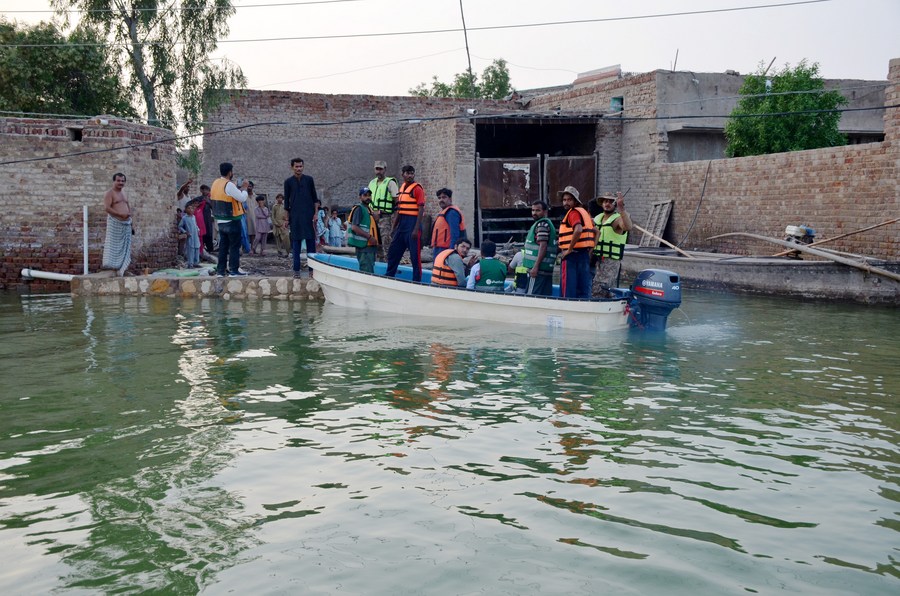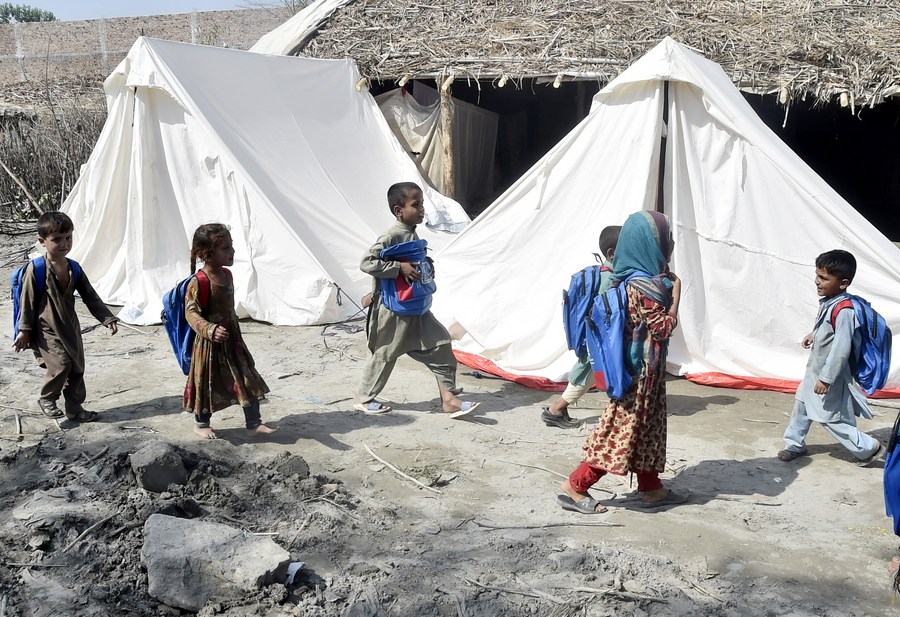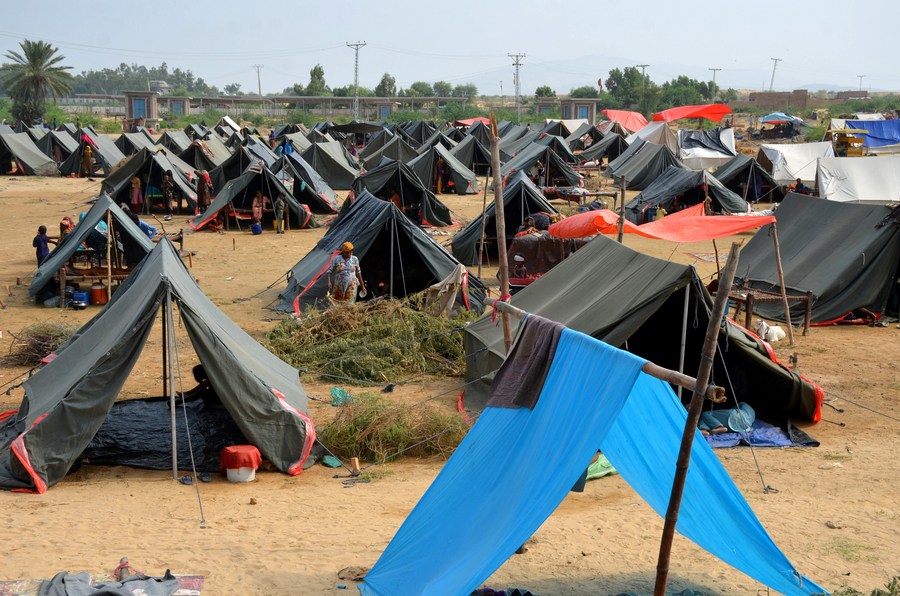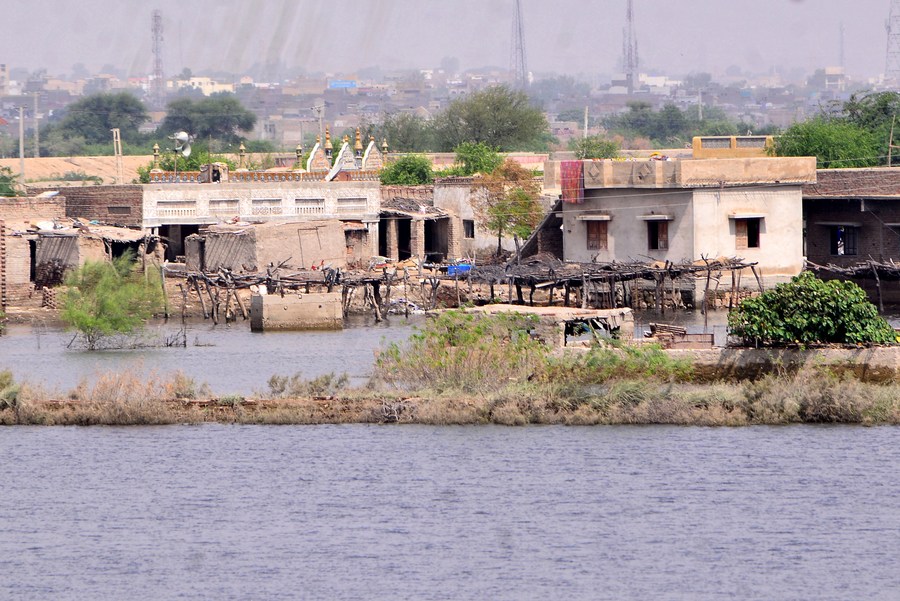A flooded area is seen in Jamshoro district, Sindh province, Pakistan, Sept. 18, 2022. (Str/Xinhua)
Agriculture has been hit hard by floods in Pakistan, where climate change-induced flooding has endangered food security and people’s livelihoods and disrupted agricultural exports, with more than 8 million acres of crops damaged and over US$1.34 billion lost in the country.
by Raheela Nazir
ISLAMABAD, Sept. 24 (Xinhua) — Pakistan’s agricultural sector, which contributes 24 percent to the country’s gross domestic product and is the biggest earner of foreign exchange, has been damaged by recent climate change-induced floods that have jeopardized food security and the well-being of populations. livelihoods and disrupted agricultural exports.
The catastrophic floods damaged over 8 million acres of crops including rice, cotton, pulses, oilseeds and vegetables and inflicted losses of over 320 billion rupees ($1.34 billion Americans), officials from the Department of National Food Security and Research said. , adding that the livestock sector has also suffered huge losses, with more than a million animals perishing due to the floods.
In addition to agricultural and infrastructure losses, heavy torrential rains and flooding have killed nearly 1,600 people, injured more than 12,000 and affected up to 33 million people since mid-June, according to the latest statistics from the National Disaster Management Authority.

Rescue workers evacuate flood-affected people in Jamshoro district, Sindh province, Pakistan, Sept. 15, 2022. (Str/Xinhua)
With a third of the country submerged, the Federal Government of Pakistan has estimated the total cost of economic damage from the floods at $30 billion, calling on the international community to assist in relief and rehabilitation efforts.
Pakistani experts believe that the government should mobilize all financial and technical resources to avert the country’s looming food security crisis and play a vital role in getting the key sector back on track.
Pakistan’s agricultural sector remained crucial to the country’s economic growth and development and accounted for half of the employed workforce, but recent climate change and erratic extreme weather events have taken a heavy toll on the sector, said the Chairman of the Pakistan Agricultural Research Council, Muhammad Azeem. Khan told Xinhua.
“All major crops have been destroyed across the country. Pakistan is the world’s fourth largest exporter of rice and the fifth largest exporter of cotton, but recent floods have destroyed these crops, affecting the country’s export revenue generation and the ‘global sourcing,'” Khan said.

Flood-affected children leave after attending a class at a makeshift school in Charsadda, Pakistan, Sept. 21, 2022. (Photo by Saeed Ahmad/Xinhua)
On top of that, he said the farming community in the country had suffered a lot, adding that the only source of livelihood for the community was their crops and livestock which they had lost significantly in the recent floods.
The responsibility now lies with the government to provide farmers with special incentives to cover their losses to get them back on their feet, the expert said.
Loans requested by producers in flood-affected areas should be rescheduled and interest on agricultural loans should also be waived, Khan said, adding that the current government has taken steps and adopted careful policies to restore the community and that there is still much to do. be finished.
Muhammad Azam Khan, a professor at the Pir Mehr Ali Shah Arid Agriculture University in Rawalpindi, said flooding in many districts has destroyed arable land as continuous flooding has made it unsuitable for planting crops. winter, especially wheat, which contributed 72% of the country’s daily calorie intake. contribution, stressing that the country could face a food crisis if preventive measures are not taken.
The country is already facing a huge shortage of wheat. With the delay in planting time due to flooding and land degradation, Pakistan could face severe shortage of wheat and other winter crops, Khan told Xinhua.

Tents of flood-affected people are seen in Jamshoro district, Sindh province, Pakistan, Sept. 15, 2022. (Str/Xinhua)
“The drying up of the flood-affected parts of the country should begin immediately…any failure will have consequences for the planting of winter crops, especially wheat. In addition, the government should import more wheat to overcome the shortages,” he said.
He said growing crops that have been planted since the start of the monsoon season, such as rice, cotton, pulses, fodder, onions, tomatoes and other vegetables, have been washed away. or damaged by flood waters. plant winter crops to ensure food security and reduce import bills.
In a conversation with Xinhua, Syed Waseem-ul-Hassan, food security commissioner at the Ministry of National Food Security and Research, said South Asian countries, including Pakistan, have become hotspots for extreme weather events linked to climate change, noting that flood-induced disasters have increased in frequency and magnitude in recent decades.
Highlighting the disproportionate impacts of climate change on poor countries, the official said Pakistan bears the brunt of climate change despite having less than 1% share of global carbon emissions.
A global compensation mechanism should be introduced to help developing countries that face huge losses from the impacts of climate change, the official said.■











More Stories
Sri Lanka’s post-harvest losses in agricultural sector exceed Rs. 55 billion – – The island
SAU Vice-Chancellor emphasizes effective research in agricultural sector
Agriculture sector threatened by climate change, expert says – Pakistan